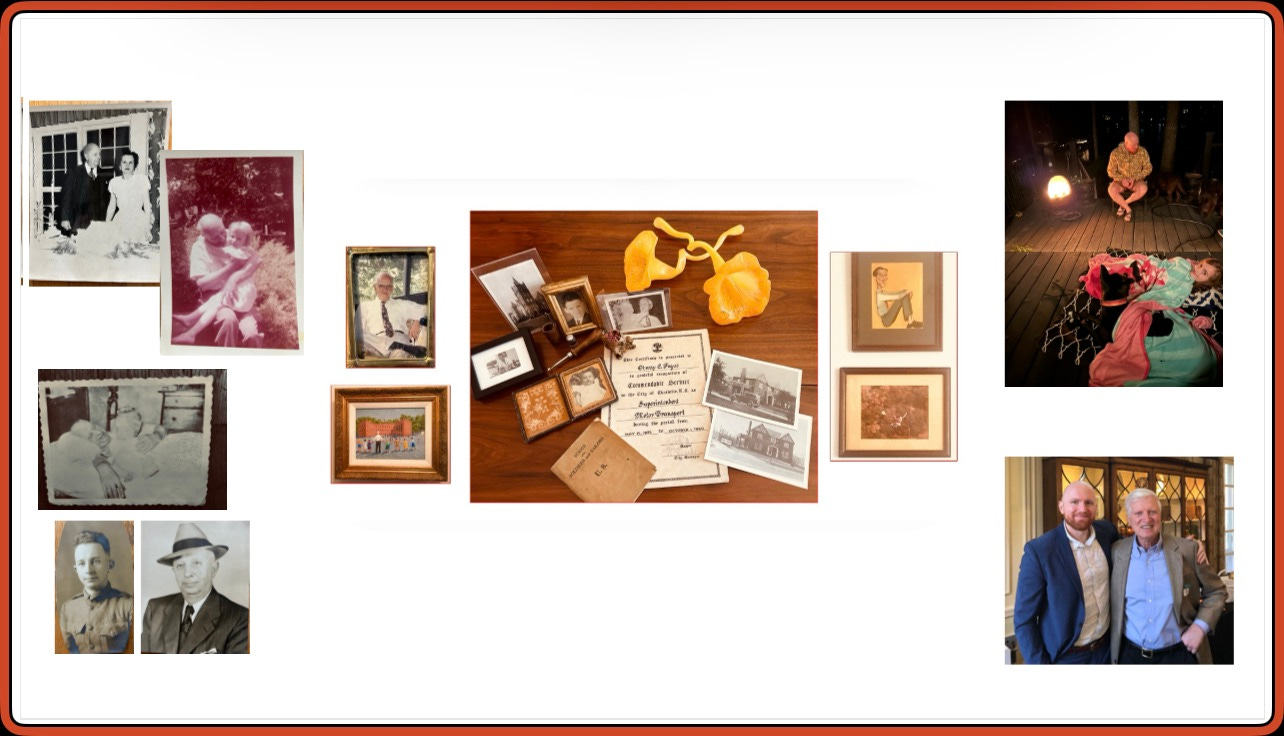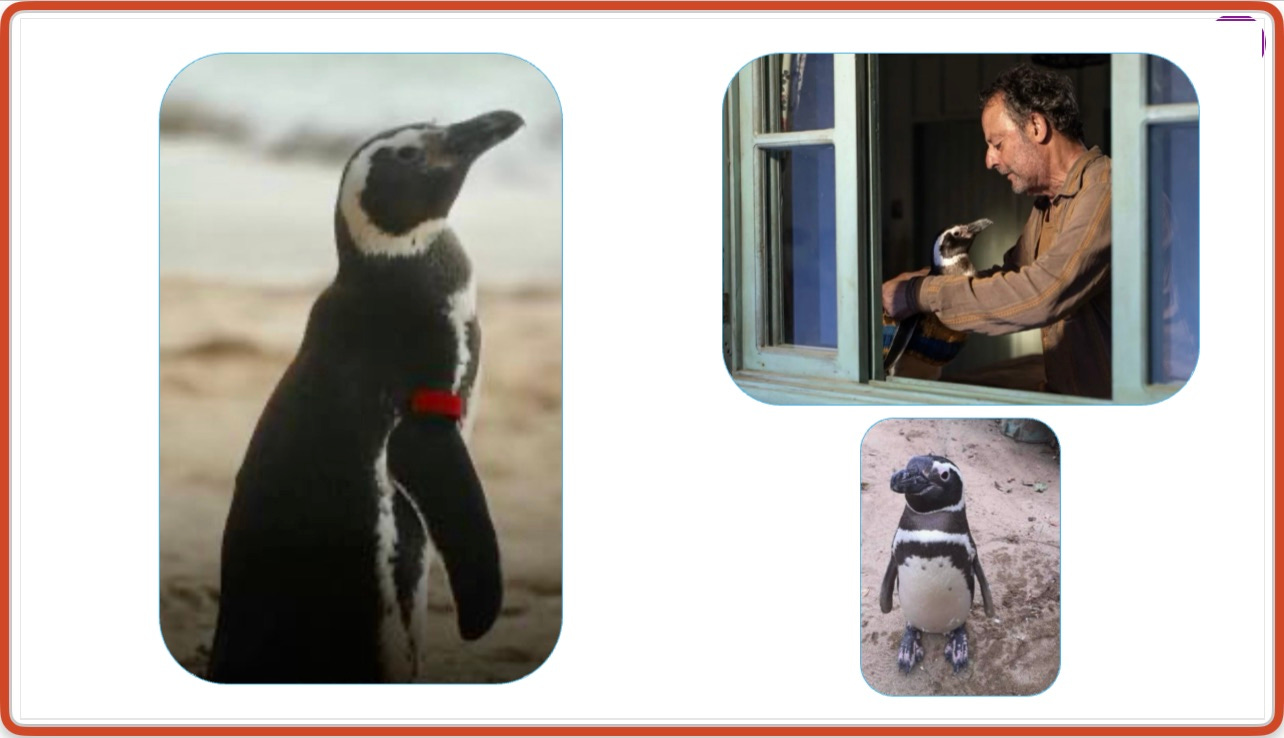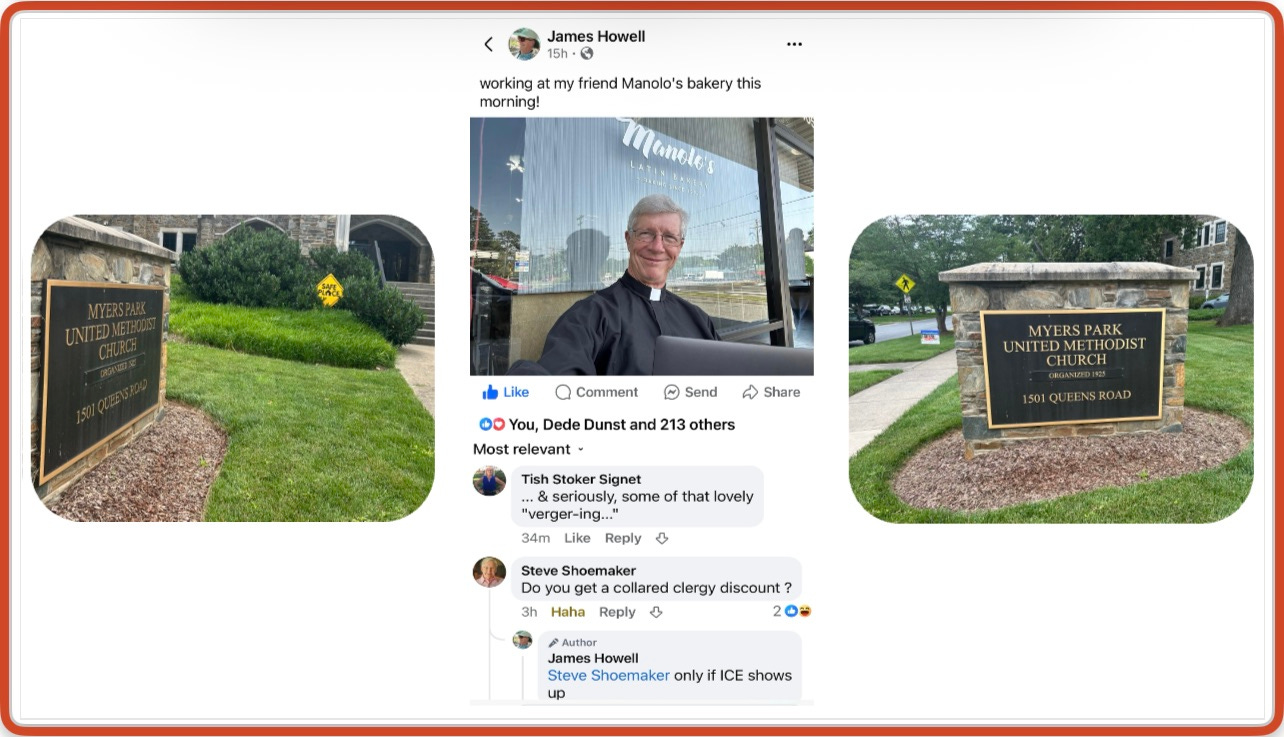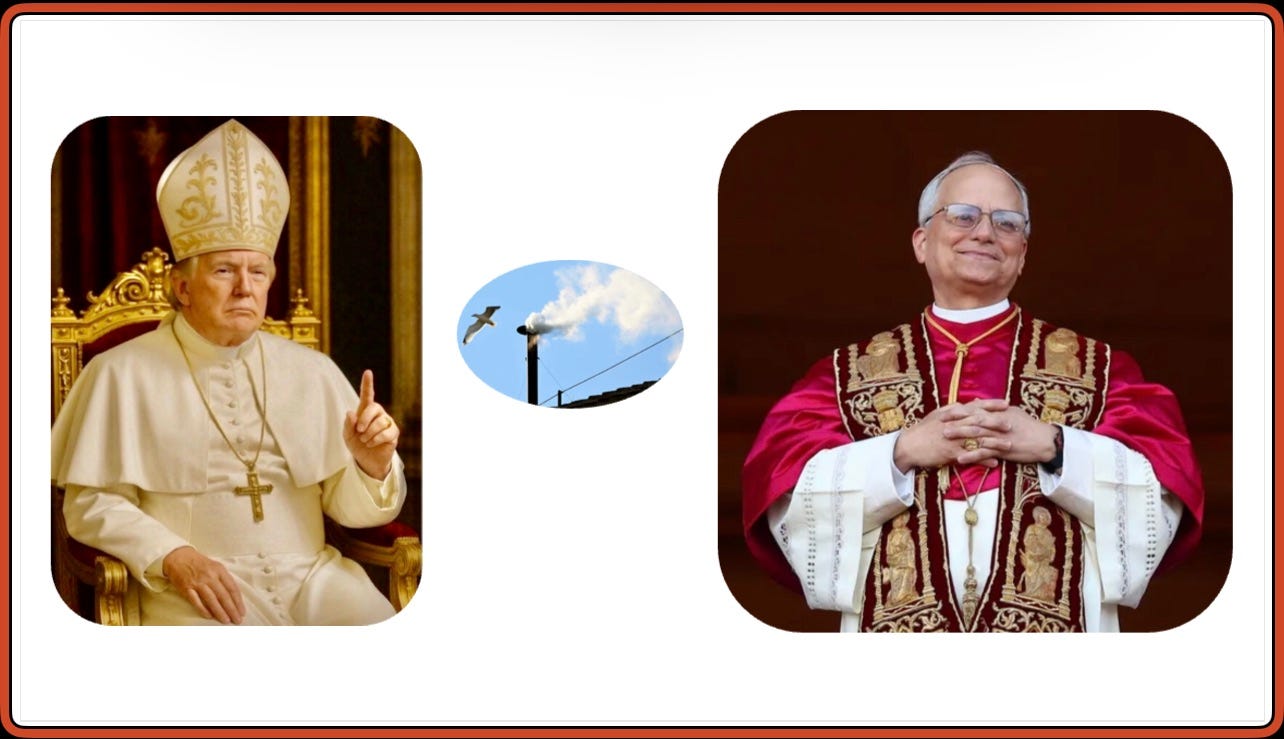Father’s Day greetings to all sorts of dads — you’ve inspired so many past-favorite posts!
This year, from the night-sea depths a quirky little movie has surfaced a celebration-song in a wholly different key.
Maybe that befits the time we are in.
At its heart My Penguin Friend is a hymn to fathomless father-son love:
through irretrievable, unspeakable loss…
to the sacred healing love that arrives only in its own time…
persistent across miles and seas, covered with muck, entangled in kelp and shedding saltwater…
to show up here, an absurdly joyous, irresistible…
Penguin?!
(For streaming, the movie’s included with Hulu and Disney subscriptions or rentable on YouTube, Amazon Prime, Apple TV et. al.)
And here’s to some of the human sons, daughters and fathers from various prior editions, such as Smiles of a Summer🌞Solstice 2023, Soul Men/Whole Men 2022.

Logistical notes on this weekend
Going forward, newShrink will be on a routine of writing (something) daily & posting (something) mostly Sundays. Especially in these head-spinning times, much longer between posts than that and my head, notes and photo library are overloaded to capacity. Then I’m NOT the most pleasant, much less coherent, person to be around!
Today’s one-time Friday post was a holiday-weekend call. In news all week from the west coast there’s aggressively militarized Los Angeles — strategic escalation at the bidding of Donald Trump. In our nation’s capital city, generations of heaviest Army tanks and equipment are lining streets — poised for tomorrow’s huge “NON-celebration” of this President’s NON-birthday.
Meanwhile, headlines like this from the Observer — ‘Rigged’? ICE agents are arresting people at Charlotte’s immigration court’ — are tip of the, um, iceberg. With dizzying speed, the strong-arm showmanship of ICE here in the greater Charlotte area (among scores of others nationwide) is officially, via our relationships, “inside.” It’s in many of our homes, neighborhoods, churches, schools, workplaces. Unlike with more generic and anonymous broad group protests, these latest tactics — cruelly — twist one’s best-intentioned efforts to support, call-out and advocate for individuals and groups with whom we have long-valued, respectful mutual relationships. Such efforts are just as likely to instead put a spotlight and deportation target on those doing their best to comply with all of the many steps and deadlines on the way to green cards and full citizenship.
This past six months, I had already been revisiting, thinking with renewed appreciation for the diary-content of the classic Mary Chesnut’s Civil War and the remarkable fact that from age 38 until the end of her life, she undertook to do it at all. Today, as never imagined doing or needing to, I’m looking at her again — this time more closely at how she did it. I’m sure there’s more to come in future editions on this, and her.
All things considered, this seemed about the best Father’s Day weekend — maybe, ever — to be totally off-grid somewhere, on a lake or woodland stream. (Or maybe a desert energy-vortex.)
Please, let’s be careful out there. And kind.
🔵
“My Penguin Friend” and care of the psyche (our own, and America’s)
The penguin movie has mostly won accolades. Positive reviews note its cinematography, nuanced acting and fact that some 90 percent of the penguin scenes are natural shots. Computer-generated imagery (CGI) is used only for dangerous scenes on steep cliffs and rough seas. Unlike one reviewer, rather than “relatively boring,” I found the sections depicting alternate-location Patagonian scientists well-presented. Nuanced not polemic, they portray many of the important moral choices involved with environmental study of creatures in wild habitat vs controlled setting.
In featured interviews and reviews of the movie, I have been disappointed not to see discussion of what’s most psychologically compelling, more broadly important — and difficult to portray so accurately and well. It’s especially in the fisherman’s pivotal ultimate ocean-rescue scene with the penguin. That is, the way in which healing for memory and grief that are complex, deeply buried and unexpressed — thus traumatic — must come first through the body, not words, and usually noisy and messy and salty and wet.
It also must come via repetition-reenactment, until the unbearably painful content is part of a broader, different narrative, alongside more “ordinary” contexts and perspective. This is like having to re-break a long, unset broken bone of the psyche, enabling it to heal in the right direction to function as part of the rest of the Self.
It is how individuation happens, how we become more whole, deeper, more resilient and compassionate of self and other, with fewer areas of ourselves alienated and split-off. It’s the very definition of living-into ever greater integrity. Living larger and spaciously. (This, too, is quietly evident in the film.)
All of this, up-from what the Jungians term the soul’s night-sea-journey! And just after Pentecost, when Christians celebrate the holy spirit’s earthward descent — symbolized as a pristine white dove. (Presumably an airy-dry one, based on its image depicted as the Methodists’ logo.)
Strangely charged times.
🔵
It is the above kind of process that’s largely nonexistent, for so many, for so long, across now generations of American society and family today. We do “up” and “more” and “bigger” and “tougher” with ever more manic frenzy to keep-it-up. Beneath and beyond the news and history and politics and economics, in a real sense we’re more like an America — and Americans — in PTSD.
Watching and listening to so many elected officials, journalists trying to make sense of them, leaders, opinion-setters, influencers, yelling fast at a fever pitch, can you imagine even raising or finishing a thought on such topics? Much has been said and written, of Donald Trump and others in his closest orbit, about the utter lack of a sense of humor or its mindful elements like irony, self-deprecation or even capacity for a genuine belly laugh.
Of late I’ve become similarly fascinated by the many dimensions and expressions of plain old, human (and sometimes divine) tears. (This interest has intensified, as I’m reading in a group and pondering the excellent book, pictured below, by Franciscan priest Richard Rohr, The Tears of Things: Prophetic Wisdom for an Age of Outrage. I highly recommend it and will be writing an entire newShrink about it.)
I’m pondering ideas that Rohr develops, about highly charged times like today’s political polarization, in which he describes cycles of order, disorder, then creation of new order. This has some alignment with classical/archetypal cycles of initiation — which as archetypes do, span cultures across millennia and across our life spans.
Rohr adds an element he deems essential, holy disorder — which is the intentional, conscious, even sacred containment, holding of the warring forces of disorder (rather than submission to the back-and-forth power-driven reactivity.) This is remarkably similar to Jung’s description of “holding the opposite tensions under pressure” that is essential for the transcendent (holy?) third state of things to emerge. Here’s part of Rohr’s concept:
Those who love order need to be humbled by the experience of holy disorder. Those working through disorder need the insight of reorder, plus a major respect for some basic order (the true meaning of a conservative), and any new reorder (which progressives love) will soon need a further disordering. It is the natural flow of grace, for both our individual lives and the lives of our institutions…
Somehow, this reminds me anew of how much I have been thinking about Lincoln, at the beginning of his presidency and our country’s previous Civil War. Early on, his focus was not at all on the abolition of slavery, or his ultimate act of emancipation. His early, immediate — and arguably existential for the nation — priority was on holding the union together amid violent extremes.
Not yet having read further, I was reflecting on just how to think about or envision this needed holding of today’s disorder — which mostly seems anything but holy. As she often does — uncannily, usually early in a morning — my dear longtime friend and reader Mickey Addison sent me a text that continued past ongoing conversations with little to no explanation. The ongoing general topic, "all the times I've tried to be a bridge."
As often happens with her, the synchronistic image she offered is as though she too had been reading Rohr’s ideas about holy disorder in times of chaos. Here’s what she wrote:
The Gazebo (Mickey Addison)
I thought I could be a bridge…joining opposite sides that just kept getting further apart but trying to hold both ends was breaking me apart. So, I took a seat to ponder for a bit; in a gazebo and realized, I could welcome others to come sit, from their opposite sides, and just breathe, be heard and maybe with love and respect, hear another voice.
🔵
This is all weighing on me, as a shrink, a human and a lifelong writer — the latter term used here in the diarist/”basic witness” vocational, not the professional career sense. Most simply, for newShrink 2.0 that’s shifted the emphasis —in the punny name from the first syllable “news” to the second, “shrink,” within the depth-psychology focus on ways to deepen and thrive amid this difficult, uncertain time. It’s most simply a focus on individuation — first our own, which then forms and informs what we are as society and world.
What this looks like: Practical newShrink 2.0 stuff:
More reliance on the expert pros in journalism and history already covering, providing source links, and presenting commentary and context in their areas of expertise. This avoids duplication and frees more bandwidth, time and energy for mine.
If we’re following only one thing a day and want it to be comprehensive with all sources linked, Heather Cox Richardson is still the gold standard (along with checking in with your own curated news sources.).
Issues, headlines and their sources will be referenced as relevant, and if you can’t get and need a hyperlink to a mentioned item just email me and I’m happy to provide it.
More posts will focus on a single or related issue(s), idea(s), book(s). When not readily available, these will include links.
Over time, posts will likely be more in-the-moment diary-form, “finished” or not, short or long or interrupted as days go. (Both “diary” and “journal/journalism” are diurnal, do have Latin roots in “daily,” after all!)
Speaking of which, for time and logistical reasons, this next section is just a non-exhaustive high-level list of a few features and themes to expect as 2.0 takes shape.
🔵
#1. Now… & Then: The past speaks, and teaches
Expect here to meet, and periodically read about my late Charlotte-native maternal grandparents, Ott and Ruby (yes, their real names). Uncannily pretty much exactly 100 years ago, amid very similar world-and-domestic political, economic and cultural dynamics, by the early 1930’s, when they were ages 32 and 36, respectively, along with the nation and world, the fabric of their entire lives, hopes, dreams, plans were ripped apart/blown up, with permanent impacts on their values and world view — as is happening to so many of similar age and life situation today. There’s a remarkable amount of saved records, newspaper clippings, photos, and books depicting their pivotal moments. Between that and significant, intimate time I spent regularly (without my parents) in their household for the first 11 years of my life, theirs might be an interesting perspective — and there are some funny and colorful stories!
#2. Fault lines.
Each of these, very different books with some common core themes, merits its own spotlight in an upcoming newShrink. Some of Rohr’s ideas are introduced above, to be expanded on.
The Presnell book is one of the finest — perhaps the finest — of memoirs in my memory. It’s important to me, on so many levels, that full discussion of it will be written as a dedicated post — and when I’m rested!
# 3. IRL the news arrives on our doorstep, in the laundry room, the church, the pre-school pickup line….
Highlighted at the top of today’s post, stories and responses to this will, unfortunately, surely be recurring. (Btw, Methodist senior pastor James, here, is not a collar-wearing Catholic cleric. The Methodist Conference had already filed a lawsuit against ICE violations of safe-place protections of churches and church schools .)
#4. The Ineffable — those moments when the tectonic (archetypal) plates are shifting…
Don’t know about you, but I saw this Trump as Pope meme — with gut punch horror, and I’m not even Catholic — soon after his White House released it on social media. This was just before the arriving cardinals from all over the world, all of whom most likely aware of the terribly offensive meme, went into sequestered isolation to begin the process of choosing the new pope. Having read-up on each of the short-list candidates, and their likely Trump-ally-or-opponent stances, I also had just rewatched the movie Conclave. When news came that the pope would be this LeoXIV, not a Trumpian choice in many ways, for me it seemed this may be the one situation where Donald Trump went too far, was outmatched. Juxtaposed, the photos and white smoke have “forces of good vs evil/everything black and white” sensibility that has lingered. (I should note, I am very susceptible to much of the ritual of the Catholic Church, especially when there’s a lot of incense. We once took then-young son Nick to the ultra-long, evening Easter vigil service. There was so much incense over so long a period that I was starting to see statues move. Nick enjoyed alerting his dad urgently, with “We gotta get her out of here, she’s getting high!”
# 5. (and that wasn’t even counting on synchronicity AND a new pope…)
Scene is still May 8, a little before noon, when silent TV news chyron announces “we have white smoke,” signaling the pope selection has been made — but NOT who, for 15-20 minutes or more. From the Charlotte condo I’m due for lunch with old high school friends Robert and Robbie, at a nearby Asian fusion place. It’s walkable but super hot, so I drive. It’s a very familiar neighborhood, and with the restaurant being across from a popular coffee shop on the other corner with limited parking, I automatically go around to enter the street so I’m able to take the closest available street-parking space on the right.
Listening intently to the car radio for the identity of the new pope, I call my lifelong friend Susan Lander Fowler, whose birthday is that day. I’m not paying attention to where I have parked, until I hear the name of Robert Prevost, who will be pope, and with that question answered I get out of the car.
That’s when I look up & gasp: I’m right in front of my late parents’ house of some 30 years. They bought and renovated it in the late 70’s for its separate-entry suite that enabled first my paternal grandad, later my maternal grandmother, to live with them. (Later they also bought and renovated the house next door, to which I oversaw an addition during my dad’s declining years.)
Here at the original “315” house, instead of a tear-down/rebuild so prevalent in these hugely in-demand older neighborhoods, it is undergoing a pretty pitch-perfect renovation that’s architecturally great and aesthetically a needed update. What had been the added-on wing for the in-law suite has been redesigned as a full part of the house, with roof gable echoing the one in front. There’s a great new large, covered front porch with second set of steps, and gorgeously welcoming slate walk and steps to the street. Some landscaping touches from my late uber-gardener-mother remain — a couple of her specialty boxwoods, and the always pruned to scale magnolia she planted, in bloom.
I was an adult by then, and never lived in that house. But over a long stretch of my young to middle adulthood, it was site of holidays and extended family ritual events like funeral visitations, bridal and wedding teas, showers etc. Birthday-Susan on the phone had actually been feted there, at her “bridal tea for the grandmothers,” way back when she and her (now-amiably-long-time) ex were married.
Taking pictures and realizing I need to dash and meet the guys, I snap one more: It captures the name and closeup of the well-designed contractor’s sign.
It reads:
“Faithwood Construction.”
Of course it does. (Well, there was white smoke…)
#6. writing home: workspace!
The centrally located Charlotte condo, as you may recall, was primarily investment for gradual transition (likely over a few or several years) between long-time home at Lake Norman and downsizing to Charlotte full-time. It’s planned and set up as readily sharable, with writing friends enjoying space for interviews and uninterrupted writing, those needing overflow lodging, etc. It’s great for small gatherings, and we’ve talked about doing on some regular basis — facetiously naming it for some French “salon.” (Then realized that would have to be at lunchtime — or maybe daybreak breakfast fare — for all who must be home by dark and relish early bedtime!) Seriously, if you’re in the area, do get in touch and come visit — especially if you live elsewhere and ever still visit Clt.
A pleasant surprise has been how quickly and seamlessly my Jungian individuation/life choices work has meshed naturally with spiritual direction/vocation practice here. (I had done this fairly extensively for a time in Davidson with a Duke Divinity & Med School-funded program, working with clients who were military, university and hospital chaplains and clergy of all ages.)
For church and also private-individual and small group practice, I am creating a “finding-our-soul-story”/spiritual direction program and some continuing education in these areas. I know some of you have participated and/or worked in this area and would greatly value hearing about your experience. (I’ll treat you to lunch!)
Here’s some of the space. Pix later from big deck still in progress and good for meeting etc. too.
Btw, the two Labradors (photo at bottom left) do relinquish their space to grownups for their kennel and the dog covers come off sofas when necessary.)
#7. writing home: lifespsace
Meanwhile more personally, being both an old-time-familiar native and a curious newbie in one’s hometown is surprising and rich. Connecting/reconnecting with people, the combination of familiar and freshly new discoveries adds so many more layers with them. I am very grateful for my decade-plus graduate school years of immersion and close ties on the west coast, and for decades centered around Davidson/Lake Norman; think I’m a bit more of a wild child, freer spirit than I would have been. I love and enjoy Charlotte more than had I been here continuously.
A few people have quoted the famed Thomas Wolfe title theme (You Can’t Go Home Again) to me, I think by way of referring to growth, landmarks torn down and such inevitable changes. I think the Wolfe quote has it wrong, at least in the casually literal way that it’s usually tossed about. It’s been countless decades since his work was topic for my junior high term paper (typed, with footnotes.) I’m fairly sure he didn’t mean the quote that way, either.
Along these lines, a favorite:
T.S. Eliot, “Little Gidding,” from 4 Quartets
We shall not cease from exploration
And the end of all our exploring
Will be to arrive where we started
And know the place for the first time.
I might even consider it essential, for the sake of our individuation and wholeness, that we — figuratively if not literally — go-home-again… and again… and then again.
My thinking here is perhaps more like the teachings of Eastern disciplines (and maybe fishermen): that we never enter the same river twice. A good and vital kind of thing.
And, that is all I have! Talk to you next week.
🦋💙 tish
… it is important that awake people be awake,
or a breaking line may discourage them back to sleep;
the signals we give — yes or no, or maybe —
should be clear: the darkness around us is deep.
— William Stafford, “A Ritual to Read to Each Other”
🔵








